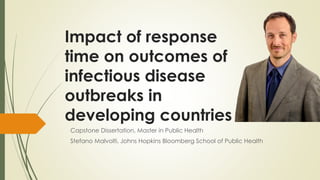
Impact of Response Time on Infectious Disease Outbreaks
- 1. Impact of response time on outcomes of infectious disease outbreaks in developing countries Capstone Dissertation, Master in Public Health Stefano Malvolti, Johns Hopkins Bloomberg School of Public Health
- 2. The recent Ebola crisis stresses the importance of timely response to outbreaks Source: http://www.cdc.gov/mmwr/preview/mmwrhtml/mm6435a6.htm
- 3. This work tests some hypotheses on outbreak response timing Outcome of infectious disease outbreaks (measured as number of cases) is influenced by timeliness of response Different diseases triggers different response times thus making the impact of different response times more or less relevant. High reproduction numbers and long incubation period may make the timeliness of detection and response more critical (a generalisation of the prior hypothesis) Stronger health systems and wealthier countries can afford a slight delay in response since that answer to the health threat will be more effective and thus likely to lead quickly to control of the outbreak under
- 4. Study sample built out of WHO Global Alert Response database GAR Database 2295 entries Single Outbreaks 658 Relevant Single Outbreaks 420 Outbreaks Included 171 Combination of multiple entries In Endemic Areas 120 In Developed Countries 67 Single Entry 67 Ongoing 16 Special Cases 1 Non infectious diseases 5 Not Sufficient Info 229 Single Case 20 identificationScreening&EligibilityInclusion
- 5. Basic descriptive and univariate statistics applied to elicit valuable insights Mean Median Correlation Coefficient between delay and cases Chi-squared Test on transformed categorical distribution Stratification (cut off points): by disease, reproduction number, Health Systems strength (physicians/10k inhabitants), wealth (GNI / capita), incubation period Transformation: from continuous into categorical with two values based on cut off points (by disease, R0 = 3, HSS = 0.3 physicians/10k inhabitants, GNI/capita =1800$, incubation = 7 days)
- 6. Type and quantity of data trigger biases and limitation Absence of many outbreaks into GAR database – selection biases Secondary data sources - no categorise sources in term of quality and reliability (15% peer reviewed articles, 15% of data from US CDC or WHO) information biases Exclusion based on Incomplete information related to several outbreaks - selection biases Use of different sources for different data point for the same outbreak – analytical biases Lack of transparency concerning the adherence of the various data sources to similar definitions for most of the parameters (e.g. index case or date of notification) - misclassification biases. Index Case Notification Date Response Date Last Case Number of Cases Number of Deaths
- 7. Data distribution and split among variables reflect specific nature of the dataset
- 8. Average response time in developing world is a major cause of concern Average response time is 60.4 days (2 months) The fastest 25% responses took approximately 3 weeks (22 days) The slowest 25% responses took 3 months (89 days) Up to a maximum of almost 9 months (259 days)
- 9. Response time has not improved over time, another reason for concern OVERVIEW All Cholera Mening YF # 171 37 34 30 LD - LC 51% 59% 50% 40% LD - HC 11% 16% 12% 3% All LD 63% 76% 62% 43% HD - LC 30% 11% 26% 33% HD - HC 8% 14% 12% 23% DELAY MEAN 60.4 38.1 63.0 75.9 STD DEV 49.8 46.2 33.9 44.2 MIN 3 3 15 9 1st Quartile 22 12 34.75 42.5 MEDIAN 49.0 16.0 57.0 69.5 3rd Quartile 89 48 91.5 110.25 MAX 259 193 142 165 2 5
- 10. Better performance of wealthier and strong health systems countries confirmed OVERVIEW # LD - LC LD - HC All LD HD - LC HD - HC DELAY MEAN STD DEV MIN 1st Quartile MEDIAN 3rd Quartile MAX below 0.3 above 0.3 under 1800 above 1800 Weak HS Strong HS Low GNI High GNI 135 36 130 41 45% 75% 48% 61% 13% 3% 14% 2% 59% 78% 62% 63% 33% 17% 29% 32% 8% 6% 9% 5% 64.1 46.5 61.5 44.0 49.6 48.7 61.5 83.0 3 3 3 13.00 25 12 24 16 52.0 26.5 49.0 28.0 92.5 57.25 90 39 259 175 259 141 1 8 7
- 11. Substantial differences in response time exist between different diseases Cholera Meningitis Yellow Fever
- 12. Delay in response influences number of cases but other variables play a role
- 13. Yellow Fever outbreak response requires much longer time Substantial difference in response time between diseases Much longer delays in Yellow Fever response compared to the other diseases. Progressive reduction of focus as result of availability of vaccines for diseases with higher mortality (e.g. Pneumococcal and Rotavirus vaccines) may have played a role More limited spread of disease and much smaller number of average cases per outbreak may be perceived as less threatening by health authorities and political decision makers.
- 14. Relevant gaps in availability and quality of outbreak response data Absence of a quality and systematic global cross-disease source of data for outbreak WHO’s Global Alert Response database where country-reported outbreaks are meant to be recorded and updated includes only a limited number of outbreaks and for the one included key data are often missing, final updates on the outcome of the outbreaks are almost never recorded, output from other works (e.g. published papers or reports from other implementing agencies) are not captured overall quality of the data can be greatly improved (more updated or different data can be found not infrequently in other validated sources).
- 15. More work to do! Limited number of data point, quality limitations and limited significance of the analysis hinder ability to draw conclusions that by clearly identifying drivers of the problems provides compelling argument for change extend and further validate the analysis than discuss emerging insights Absence of a solid complete and reliable source of information greatly penalise future efforts aimed at improving the understanding of the outbreaks and the best way of addressing them consider the creation of a global outbreak database